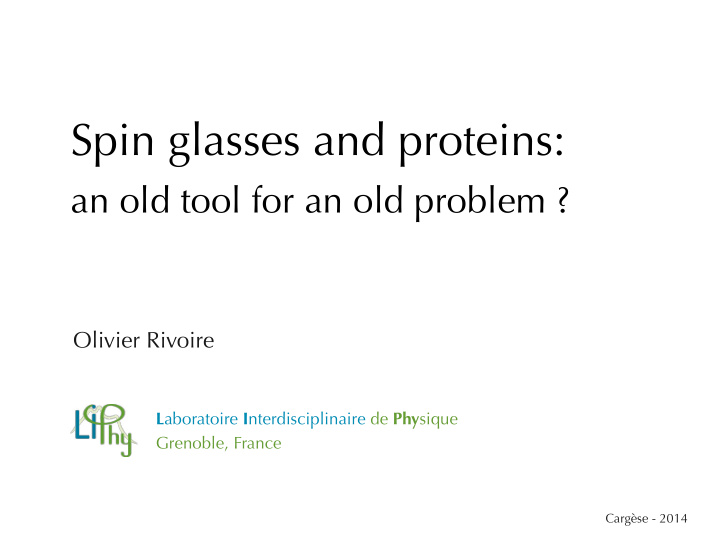



Spin glasses and proteins: an old tool for an old problem ? Olivier Rivoire L aboratoire I nterdisciplinaire de Phy sique Grenoble, France Cargèse - 2014
Two old problems (1) (2) SEQUENCE STRUCTURE FUNCTION (1) Folding How do proteins find their ‘native state’ ? Understood in principle (with ideas from spin glasses) Funneled energy landscape / principle of minimum frustration Bryngelson & Wolynes, Spin glasses and the statistical mechanics of protein folding , PNAS 1987 [Review] Dill et al., The protein folding problem , Annu. Rev. Biophysics 2008 (2) Function How do proteins work ? New quantitative data
Saturated mutagenesis Effects of point mutations on the binding affinity to a ligand (in PDZ): McLaughlin et al., The spatial architecture of protein function and adaptation , Nature 2012 3d view: How to understand this map ? ‣ Evolution: conservation and coevolution ‣ Experiments: allosteric effect
Allosteric regulation Definition: regulation of an ‘active site’ by a distant site on the protein Repressor: Hemoglobin: Repression of gene transcription : RNA polymerase repressor DNA gene PDZ: Activation : inducer gene Monod, Changeux & Jacob, Allosteric proteins and cellular control systems , J. Mol. Biol. 1967 [Review] Smock & Gierasch, Sending messages dynamically , Science 2009
How to understand this “structure” ? Effects of point mutations on the binding affinity to a ligand (in PDZ): McLaughlin et al., The spatial architecture of protein function and adaptation , Nature 2012 3d view: ‣ Evolution: conservation and coevolution ‣ Experiments: allosteric effect It need NOT be PHYSICS, it may be EVOLUTION A spin glass model for the evolution of allostery
A spin glass model (1): binding fixed structure amino acid physical state environment (lattice) (ex: orientation) (ex: ligand) 3 types of variables / 3 time scales Solvent: Ligand: ( i ∈ bottom) Binding free energy:
A spin glass model (2): allostery fixed structure amino acid physical state environment (lattice) (ex: orientation) (ex: ligand) Allosteric efficiency: = how much better binds in the presence of ` m
Evolving spin glasses (1): principles Population dynamics: selection / reproduction allosteric efficiency random mutations [Book] Mitchell, An introduction to genetic algorithms , 1998
Evolving spin glasses (2): technicalities ‣ Gaussian spin glass: top bot ‣ Allosteric efficiency: ‣ Mutations: J ∗ ij ∼ U ([ − 1 , +1]) (uniform distribution) ‣ Parameters: (system size) (temperature) (population size) (mutation rate) ‣ Sigma-scaling rule:
Evolving spin glasses (3): results Energy: X X X E [ � | J, m, ` ] = − J ij � i � j − m i � i − ` i � i i 2 top i 2 bot h i,j i J ij ∈ [ − 1 , 1] Fitness: � ( m, ` ) = F ( ` , 0) − F (0 , 0) − F ( ` , m ) + F (0 , m ) Outcome of evolution: | J ij | ' 1 8 i, j m = (+1 , . . . , +1) Interpretation: ferromagnet with maximal couplings no sparse architecture !
Sparsity from fluctuations (1) change every m = (+1 , . . . , +1) generations τ / 2 m = ( − 1 , . . . , − 1) � | J ij | > 0 . 8 � More fluctuations more sparsity
Sparsity from fluctuations (2) δφ ij = fitness cost for mutating Functional value : J ij � large couplings � large fitness costs
� Evolutionary conservation � � � periodic boundary The solutions break the translational symmetry conditions The location of the channel is stable over multiple periods :
Phase diagram Sparsity: fraction of couplings with small fitness cost upon mutation ( δφ ij < 0 . 1) J ij Fitness: allosteric efficiency φ Sparsity Fitness τ τ period period No No adaptation adaptation mutation rate mutation rate µ µ error threshold µ > (system size) − 1 Two routes to sparsity: ‣ fluctuating selective pressures (intermediate ) µ τ ‣ mutational load (large ) µ
Sparsity beyond low fitness � � � � Systems evolved with fluctuating selection are: ‣ more sparse ‣ more ‘evolvable’ than systems with equivalent fitness φ
Geometry beyond sparsity � � temporal structure spatial structure of selective pressures of couplings in past history in present systems Fitness: binding of ` if or/and are present Probability of modularity: m 1 m 2 � � more likely to be modular when and vary independently m 1 m 2 modularly varying environment modular geometry [similar results] Kashtan & Alon, Spontaneous evolution of modularity and network motifs , PNAS 2005
How a “functional structure” may be shaped by temporal fluctuations � τ = 200 τ = 1000 τ = 400 � X X X E [ � | J, m, ` ] = − J ij � i � j − m i � i − ` i � i i 2 top h i,j i i 2 bot M. Hemery & O. Rivoire, Evolution of sparsity and modularity in a model of protein allostery, arXiv:1408.3280
Recommend
More recommend